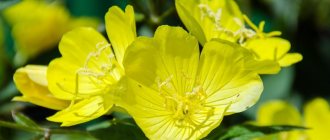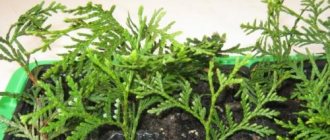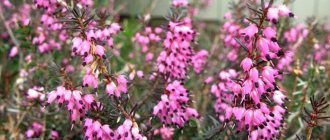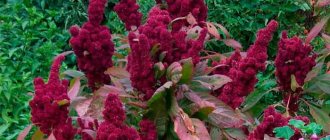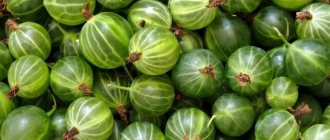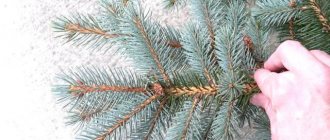An excellent option for decorating your site would be purslane. This incredibly beautiful flower rarely gets sick and does not require pruning. It can tolerate drought very well.
The plant is distinguished by needle-like thin leaves and bright inflorescences. Gardeners often choose this particular plant to decorate their plots.
Vegetable purslane is also known as a weed. Many even try to get rid of it in every possible way.
However, not everyone knows that this plant has medicinal properties.
The flower is also called dandur or mat, as it grows widely over the surface of the soil.
Purslane, planting and caring for it in open ground is very simple and affordable, can be grown in the country. To do this, use pots, flower beds or hanging baskets.
Types of purslane
Purslane in our country is grown as an annual. It got its name because of the way it opens seed pods.
If you translate the word from the Latin “purslane”, you get “collar”.
Many varieties of purslane grow over the ground and spread their leaves all over everything.
The flower grows in Altai and the North Caucasus.
Today, about 200 varieties of dandur are known.
Many of them are suitable for cultivation in our country. The plant has interesting needle-shaped green leaves.
During flowering, a variety of double or non-double inflorescences are formed. They can be white, red, pink, yellow.

Dandur is used in cooking.
It is especially common in the Caucasus. The stems are often added to salads, soups, and sauces.
It has a tart taste, reminiscent of sorrel or spinach.

This plant also has medicinal properties.
The stems are infused with alcohol and used to treat arthritis and psoriasis.
The seeds are suitable for shingles lotions. Greens are suitable for dietary nutrition as they contain a low amount of calories.
The leaves contain many vitamins, so they are suitable for combating vitamin deficiency.

Terry purslane An annual plant used to decorate terraces and flower beds. This species has double inflorescences of white, yellow, red or orange. The most popular varieties are white-flowered purslane and Splendex. Please note that only in a well-lit and dry place is it possible to achieve abundant flowering of dandur.
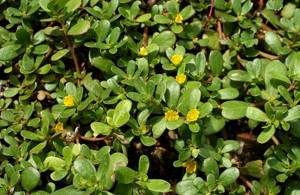
Purslane vegetable medicinal Garden purslane has fleshy green leaves, its flowers are smaller and not as colorful as those of other species. Typically white or yellow. A distinctive feature of the species is the medicinal properties of the plant.
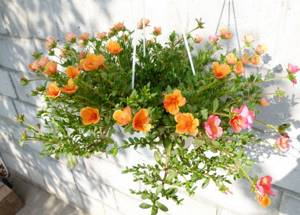
Purslane ampelous Artificially bred. The hybrid has branching stems with fleshy cone-shaped leaves. Inflorescences can be double or non-double. Flowers of pink, white, yellow, purple and other colors. The ampelous species is suitable for growing in flowerpots, hanging pots, and flowerpots. This is an amazingly beautiful plant!
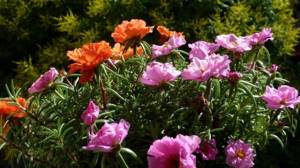
Purslane grandiflora The most common species is grandiflora purslane. In South America it grows as a perennial plant. However, in our country this is impossible. The annual grows up to 30 cm tall. The stems are lodging, the leaves are fleshy and small. The inflorescences are 3-4 cm in diameter, double, somewhat reminiscent of roses. Flowering occurs in June. The plant blooms right until October.
The following varieties are considered the most popular:
- Double Mix;
- Cherry;
- Sanglo;
- Baroque purslane.
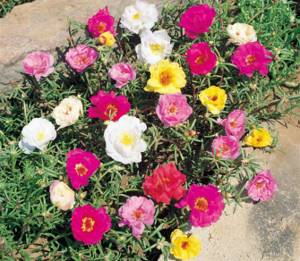
Among the terry species, the airy marshmallow variety looks impressive.

A beautiful variety of dandura Flamenco with colorful double flowers.
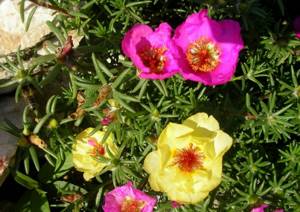
Purslane Solar Princess grows very quickly.

Stopwatch purslane is often grown in vases, baskets or pots. This incredibly beautiful flower will decorate any area. The inflorescences of the variety are very large and bright.
Growing from seeds
To plant purslane seeds in open ground, you can use independently collected planting material.
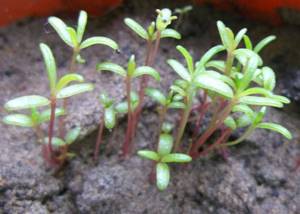
It can also be purchased at any flower shop.
For sowing, you can use seeds that have been stored for at least 6 months.
A peculiarity of planting material is that even recently collected ripe seeds are not able to germinate immediately. Seeds can be stored for 3 years.
Growing from seeds is possible in two ways: by sowing seedlings or directly in open ground in flower beds and beds.
Caring for a flower carpet on the site
First of all, it is important to take into account the fact that young seedlings are very afraid of frost. Therefore, the plant is planted in open ground when the weather does not foretell such incidents. If the temperature drops to +7°C, then you need to wait a little longer.
Planting and caring for purslane in open ground is carried out in stages. First, the procedure of pinning the sprouts is carried out. To do this, they are taken out of the room for a few minutes for 14 days. Each time the time for pinning purslane on the street increases.
Seedlings are most often planted at the end or beginning of the day. This approach helps them adapt to their environment. The most suitable place for the plant is an open sunny area. Seedlings are placed in shallow holes at a distance of 20 cm from each other. After each watering, loosen the soil until the area turns into a carpet of flowers. In the future, purslane does not need special care, so you can admire its lush blooms all summer.
Sowing seedlings
Sowing purslane for seedlings should be done around February-March.
Thus, flowering will occur at the beginning of summer. To grow purslane from seeds, you need to do the following:
- First, prepare the containers for the seedlings.
These can be wooden boxes, plastic cups, seedling pots and more.
- Next, add a nutritious soil mixture, which you can easily purchase in a store or make yourself.
To do this, you need to mix garden soil with sand.
- Heat the soil mixture in the oven at 100°C for 2 hours.
Next, cool and pour over a bright pink solution of potassium permanganate. This is necessary to disinfect the soil.
- The seeds of the flower are small, so they do not need to be sown deeply.
Simply scatter them on the surface of the ground and lightly press them with your hand. Be careful not to damage the fragile and small seeds.
- Water containers with planting material.
Use a spray bottle to evenly distribute the moisture over the entire surface of the soil.
When sprayed with water, the seeds remain in place and are not washed away by the stream, as with conventional watering.
- In order for the seeds to germinate, they need to be provided with all the necessary conditions.
The main ones are high humidity and room temperature +22-25°C.
Cover containers with seeds with film and put them in a warm, shaded place.
- After approximately 7-14 days, the first shoots should appear.
During all this time, you need to regularly ventilate the seedling containers. To do this, remove the film daily.
It is also important to monitor the condition of the soil. It should not dry out, but stagnation of water should also not be allowed.
Excessive moisture can cause fungal diseases in the plant and it may die.
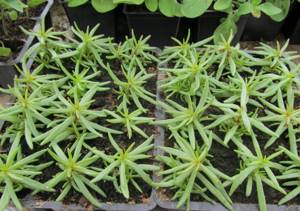
Experienced gardeners recommend using various fertilizers with caution.
Their excess can provoke an increase in green mass.
In addition, flowering may not occur at all, since the plant will devote all its energy to the development of leaves.
When the first shoots appear, you need to remove the film and move the containers to a brighter place.
At this stage of development, the dandur really needs sunlight. Due to its deficiency, plants become pale, weak and begin to stretch. The seedlings are also watered using a spray bottle.
When the seedlings grow a little and 2 true leaves appear, they need to be plucked.
Transplant into separate containers or large boxes at a distance of 4 cm from each other.
In this case, the plants are buried in the ground right up to the cotyledon leaves. They are planted in a permanent place only when the weather is warm outside.
Purslane is a heat-loving flower, so it is assigned to a permanent place of growth after spring frosts.
When transplanting, it is important to maintain a distance between plants of 10-15 cm.
Rules for caring for and growing in the garden
This culture is quite capricious and sensitive to external factors. Lack of light and increased soil moisture can stop the development of this plant. For this reason, it is so important to strictly follow all the rules of care.
Irrigation
Purslane requires moderate but frequent watering. It is important to take into account weather conditions - in hot weather, flowers are watered more often. If the soil has not had time to dry completely, it is enough to simply spray the surface of the soil near each bush. On average, water the plants once a week. This crop tolerates drought better than waterlogging, which is important to consider.
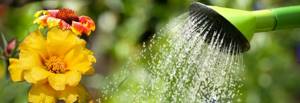
Watering is systematic and depends on weather conditions. It is important to take into account the fact that the plant tolerates drought more easily than excessive moisture.
Fertilizer
Additives are added to the soil only if necessary, for example, when the purslane began to fade or the quality of flowering deteriorated. It is best to choose complex formulations in liquid form, since the root system absorbs them better. For each plant - no more than 30 ml of solution.
But you should not use organic matter, since such fertilizers lead to rapid growth of the green mass of purslane.
Loosening, mulching
During the first few weeks after transplanting to a permanent location, gardeners need to regularly loosen the soil after watering or rain. This will saturate the soil with oxygen (it is needed for the normal development of the root system), and avoid stagnation of moisture, which can greatly harm the purslane. When the plant takes root, it is enough to loosen the soil once every 3-4 weeks.
It is also recommended to mulch the flowerbed with purslane. This procedure has the following advantages:
- retains moisture in the soil longer;
- allows you to fight weeds by inhibiting their growth.
The mulch layer is up to 6 cm. It is better to choose straw or sawdust as the material.
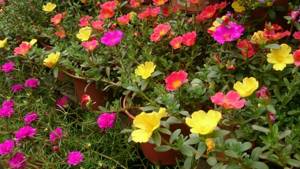
Planting purslane will decorate any garden plot
Pinching, pinching, pruning
If you do not monitor the condition of the plantings, purslane will begin to quickly spread throughout the area, becoming a weed. Prune the plant in summer, removing damaged or dry shoots. To give the bushes a rounded shape, the stems that grow to the sides are also trimmed.
Purslane also requires pinching. In this case, the work is carried out immediately after the buds bloom, which will avoid the appearance of seeds.
Wintering
Purslane is an annual plant. Therefore, it does not require any preparatory work for wintering. When the crop turns yellow, it is simply removed from the flower beds and destroyed along with other plant debris.
There are gardeners who use the culture to prepare organic fertilizer. But you should not do this - seeds may remain in the remains of flowers, which threatens further uncontrolled growth of purslane next year.
Purslane is a popular plant for decorating various elements of a site and flower beds.
Caring for this crop is quite simple, but there are several nuances that need to be taken into account when growing. If everything is done correctly, purslane will attract with bright blooms for a long time.
Planting in open ground
Dandur is a perennial plant, so it can be planted once on the site; it will germinate on its own by self-sowing.

However, purslane grows in this way only in warm regions of the country.
Where climatic conditions are more severe, it is grown through seedlings.
Planting purslane in open ground can begin no earlier than mid-April.
In this case, you need to be guided by the weather, it should not be lower than +20°C.
Choose a place on the site that is sunny, without strong winds and stagnant water.
Before sowing, you need to prepare the beds.
The earth is loosened and shaped with a rake.
You can apply fertilizer, the main thing is not to overdo it. You can buy them in the store.
It is important to follow the dosage indicated on the package. The seeds are buried 1 cm, sprinkled with earth on top.
The distance between the rows is about 50 cm. When the seedlings grow, they are thinned out, leaving the strongest plants.
When to plant depending on the region
When planting this plant, you need to take into account that different regions have different sowing dates for seedlings.
In Moscow and Moscow region
In this region, in mid-May the weather is already warm, including at night. Therefore, purslane can easily develop outside. This means that seedlings are planted in the first ten days of March.
In the middle lane
In the regions of the middle zone, as in Moscow, purslane can be planted in open ground as early as May, which means seedlings are started in early March.
In the Urals
In this region, you can plant purslane seeds for seedlings in early March. But you should choose the time of planting in open ground depending on weather conditions. It is important for gardeners to wait until the frosts have passed - the temperature at night should not fall below +10 °C. For this reason, planting dates are shifted to the end of May or beginning of June.
In Siberia
In this region, the rules for planting seedlings and planting them in open ground are the same as in the Urals: seeds are planted in March, plants are replanted in early June.
In the Leningrad region
Gardeners in the Leningrad region adhere to planting deadlines, just like their neighbors from the middle zone. However, due to unstable weather, the timing of planting in open ground may shift closer to the end of May.
If spring is early, seedlings are planted in March, but if the cold does not subside, you will have to wait a few weeks.

Flowering of purslane begins in June and ends with the onset of autumn frosts
Caring for purslane
Growing a beautiful, strong plant is not difficult. All the secrets of growing purslane from seeds are hidden in moderate watering and the right site.
Purslane loves warmth and sunlight. A sunny and dry place would be ideal.
It is not critical if shadow prevails for several hours. However, if the purslane grows constantly in the shade, you may not wait for it to bloom at all.
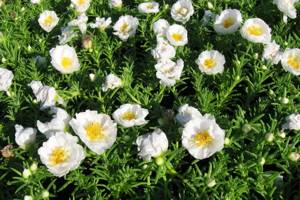
Garden flowers came to us from South America, where it is very warm and has high humidity.
Water the plant only with warm water at room temperature.
The flower can go without water for a long time. It needs to be watered once every 4-5 days.
If the weather is too hot, it is recommended to increase watering.
Stagnation of water is especially destructive for it. The plant begins to hurt, its roots are suffocating from lack of oxygen.
It is important to promptly get rid of weeds that take nutrients from the soil.
Dandur grows on any soil. It is important that the soil is loose. Sand is added to heavy soils.
If the soil is very rich in nitrogen, this can lead to vigorous development of green leaves. In this case, flowering is significantly reduced or stops altogether.
For abundant flowering, feed with complex mineral fertilizers. Over the entire season they feed 2-3 times.
The soil is also loosened. This can be done while the plants are still young. With further development, they form a continuous flower carpet, so loosening the soil will no longer be possible.
Diseases and pests
The flower is a very unpretentious plant. He very rarely gets sick, pests are practically not scary for him.

The most common pests of purslane flowers are aphids and thrips.
Aphids attack the plant and eat flowering shoots.
Treating the bushes with insecticides will help get rid of the pest.
Thrips suck the juice from plants. When these small insects are present, silvery dots appear on the leaves.
You can also get rid of them using insecticides.
One of the most common diseases affecting purslane is root rot. It occurs due to excess soil moisture.
The leaves of the plant turn yellow and fall off. The shoots gradually become deformed.
You can save the flower by treating it with copper-containing preparations.
Reproduction of dandur
The purslane plant can be grown from seeds or by cuttings.
To do this, you first need to bring the plant to a cool place in the fall and leave it there until spring.
With the arrival of warmth, cuttings are cut from the flower. Their length must be at least 5 cm. Next, they are placed in a container with water. In a few days, roots will appear on the cuttings.
Now you can root purslane in the ground. When it gets warm outside, you can transplant the plant to a new location.
Purslane is planted by cuttings, and after a month flowering begins. The main thing is that there is no frost at this time, otherwise the flower may die.
Collecting seeds
You can use independently collected seeds only if it is necessary to remove the non-double type of purslane.
The germination of such varieties is very poor, so gardeners recommend purchasing seeds from flower shops.
Other types of flowers can be obtained from independently collected planting material.
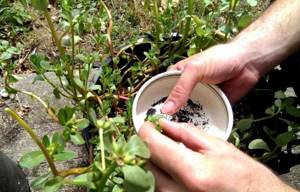
Ripening occurs unevenly, so the material is collected at different times.
The boxes need to be picked when they turn yellow.
They are still a little unripe, but otherwise you may miss cracking and the seeds will spill out onto the ground.
The collected seeds are first dried well on paper. Next, place it in a plastic container with the lid closed.
Planting material should be stored at a temperature of +4°C.
The collected planting material can be used for 3 years.
Collecting purslane seeds for propagation
This crop blooms quite profusely, but do not forget that each bud can live no more than 1 day. After wilting, the boxes close and fall to the ground. The task of any gardener who decides to propagate a crop is to collect seed material before it becomes unusable. Otherwise, they will fall into the ground and grow next to the mother plant next year. The procedure for collecting seeds is presented below.
- We wait until the plant stems turn yellow and the boxes open.
- We collect the seed and place it in a dark and dry place.
- Stretch the rope in a well-ventilated area or under a canopy.
- We tie the boxes with the hole down and lay the fabric on the ground.
- We collect the seeds as the boxes open.
It is strongly recommended not to deform the container with seeds and try to extract them from there artificially. Firstly, this risks the fact that you simply damage the seed in the process. Secondly, it is allowed to collect only those seeds that are truly ripe. The resulting material can be stored for 3 to 5 years (depending on the variety). You can use the seeds for planting next year.
